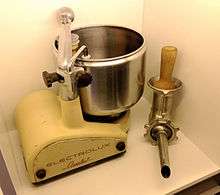Electrolux Ankarsrum Assistent
- The original that this article was based upon can be seen at sv:Electrolux Assistent in the Swedish Wikipedia.


Assistent is a household kitchen appliance, introduced by Electrolux in 1940.
The distinctive feature of this mixer is that it spins the bowl and its contents, not the stirring paddle. As a result, there is more torque and less noise. The bowl is driven by an electric motor and worm gear from beneath. The power of the motor has increased over time from 250 W[1] through 400 W, 450 W, 650 W, 800 W and now 1500 W.[2] Original machines had a simple single speed switch; modern machines have both variable speed and a timer.

It was designed by Alvar Lenning[3] and became a bestseller for Electrolux.[4] It is produced since 1969 in Ankarsrum when production was moved from Motala. It is sold today in several different colors.[1][5]
Hook versus roller debate

There is some disagreement (or discussion) between the (U.S.-based) so-called "experts" as to if the dough hook is needed or not (as opposed to the scraper and roller method).
Here are some examples: This first pair show a lighter density mixture, thus is not as relevant for bread dough users:
- Roller or dough hook? Magic Mill DLX Electrolux 1: Roller and Scraper (1:36, YouTube).
- Roller or dough hook? Magic Mill DLX Electrolux 2: Bread Hook (2:23, YouTube).
Two good examples of the different methods:
- "Assistent Original Mixer Demonstration", uses the "bread hook" method for bread dough (11:23, YouTube).
- "Ankarsrum (Electrolux/Magic Mill/Verona) Mixer Demonstration", uses the "scraper and roller" method for bread dough (16:25, YouTube).
{One source[6] claims that all sizes of bread doughs can be started with the roller and scraper, but that only rather large sized mixes will need to be transitioned to the bread hook.}
Accessories
A range of additional accessories are available, most of these are the typical accessories for a large mixer.[7] Most attachments are driven using the main drive shaft used to drive the bowl, however, some – such as the meat grinder or pasta roller – require the machine to be tilted on its side.[8] The attachments available are:
- Meat mincer
- Vegetable grater
- Citrus press
- Pasta roller
- Coffee and grain mill
- Double beater for lighter cake mixtures.
The meat mincer also has many additional attachments, such as a sausage horn, strainer or nut grinder.
One is an unusual attachment, favoured by the Swedish market
- Flake mill
- This rolls grains such as oats and buckwheat to make muesli.
One attachment, the blender, uses a separate drive shaft at the rear of the machine, this shaft has different gearing for higher rpm output.
References
- 1 2 "History". Assistent.
- ↑ http://www.purecookshop.co.uk/Assistent-Original-Food-Mixer-Matte-Black
- ↑ US D126657, Alvar Lenning, "Design for a food mixer", issued 1941, assigned to AB Electrolux Google patents
- ↑ http://group.electrolux.com/en/growth-and-industrial-design-688/
- ↑ http://www.assistent-original.com/website2/1.0.2.0/8/2/
- ↑ (A telephone conversation with "Bread Beckers")
- ↑ "The Assistent Accessories". PureCookshop. External link in
|website=(help) - ↑ "Assistent Mincer Manual" (PDF). http://assistent-original.se/en/produkt/meat-mincer/. Ankarsrum. Retrieved 20 October 2015. External link in
|website=(help)
External links
| Wikimedia Commons has media related to Electrolux Assistent. |
- assistent-original.se is the Swedish-language web page for the now parent company, Ankarsrum.
- http://assistent-original.se/en/history/ is the english-language 'History page' for the product/company.
- Ankarsrum Original USA, is the US distributor for the Assistent. Its parent company is Bread Beckers.
- Magic Mill USA.
- A three-second YouTube video of a 50-year-old model.
- The Swedish Nationalmuseum's web page (a blog entry) on the Assistent: http://www.nationalmuseum.se/sv/Skola/For-SFI-och-SAS/Projekt-Tingen-talar-till-oss/Bouchra-fran-Marocko/.
- American Electrolux - The Beginning, and the Early Years by Charles Richard Lester
- https://www.youtube.com/watch?v=5tvEz4Ko8pQ, another good YouTube video (25:24). This one also shows the mill accessory at the beginning.
- https://www.youtube.com/playlist?list=PL38C789F0854F6573, an English language YouTube Playlist "Instructions Ankarsrum Assistent English", apparently by the Ankarsrum company.
